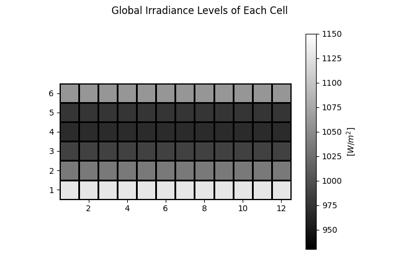pvlib.bifacial.power_mismatch_deline#
- pvlib.bifacial.power_mismatch_deline(rmad, coefficients=(0, 0.142, 3.2), fill_factor: float = None, fill_factor_reference: float = 0.79)[source]#
Estimate DC power loss due to irradiance non-uniformity.
This model is described for bifacial modules in [1], where the backside irradiance is less uniform due to mounting and site conditions.
The power loss is estimated by a polynomial model of the Relative Mean Absolute Difference (RMAD) of the cell-by-cell total irradiance.
Use
fill_factorto account for different fill factors between the data used to fit the model and the module of interest. Specify the model’s fill factor withfill_factor_reference.Added in version 0.11.1.
- Parameters:
rmad (numeric) –
The Relative Mean Absolute Difference of the cell-by-cell total irradiance. [Unitless]
See the Notes section for the equation to calculate
rmadfrom the bifaciality and the front and back irradiances.coefficients (float collection or numpy.polynomial.polynomial.Polynomial, default
(0, 0.142, 0.032 * 100)) –The polynomial coefficients to use.
If a
numpy.polynomial.polynomial.Polynomial, it is evaluated as is. If not aPolynomial, it must be the coefficients of a polynomial inrmad, where the first element is the constant term and the last element is the highest order term. APolynomialwill be created internally.fill_factor (float, optional) – Fill factor at standard test condition (STC) of the module. Accounts for different fill factors between the trained model and the module under non-uniform irradiance. If not provided, the default
fill_factor_referenceof 0.79 is used.fill_factor_reference (float, default 0.79) – Fill factor at STC of the module used to train the model.
- Returns:
loss (numeric) – The fractional power loss. [Unitless]
Output will be a
pandas.Seriesifrmadis apandas.Series.
Notes
The default model implemented is equation (11) [1]:
\[ \begin{align}\begin{aligned}M[\%] &= 0.142 \Delta[\%] + 0.032 \Delta^2[\%] \qquad \text{(11)}\\M[-] &= 0.142 \Delta[-] + 0.032 \times 100 \Delta^2[-]\end{aligned}\end{align} \]where the upper equation is in percentage (same as paper) and the lower one is unitless. The implementation uses the unitless version, where \(M[-]\) is the mismatch power loss [unitless] and \(\Delta[-]\) is the Relative Mean Absolute Difference (RMAD) [unitless] of the global irradiance, Eq. (4) of [1] and [2]. Note that the n-th power coefficient is multiplied by \(100^{n-1}\) to convert the percentage to unitless.
The losses definition is Eq. (1) of [1], and it’s defined as a loss of the output power:
\[M = 1 - \frac{P_{Array}}{\sum P_{Cells}} \qquad \text{(1)}\]To account for a module with a fill factor distinct from the one used to train the model (
0.79by default), the output of the model can be modified with Eq. (7):\[M_{FF_1} = M_{FF_0} \frac{FF_1}{FF_0} \qquad \text{(7)}\]where parameter
fill_factoris \(FF_1\) andfill_factor_referenceis \(FF_0\).In the section See Also, you will find two packages that can be used to calculate the irradiance at different points of the module.
Note
The global irradiance RMAD is different from the backside irradiance RMAD.
RMAD of a variable \(G_{total}\) is defined as:
\[RMAD \left[ unitless \right] = \Delta \left[ unitless \right] = \frac{1}{n^2 \bar{G}_{total}} \sum_{i=1}^{n} \sum_{j=1}^{n} \lvert G_{total,i} - G_{total,j} \rvert\]In case the RMAD of the backside irradiance is known, the global RMAD can be calculated as follows, assuming the front irradiance RMAD is negligible [2]:
\[RMAD(k \cdot X + c) = RMAD(X) \cdot k \frac{k \bar{X}}{k \bar{X} + c} = RMAD(X) \cdot \frac{k}{1 + \frac{c}{k \bar{X}}}\]by similarity with equation (2) of [1]:
\[G_{total\,i} = G_{front\,i} + \phi_{Bifi} G_{rear\,i} \qquad \text{(2)}\]which yields:
\[RMAD_{total} = RMAD_{rear} \frac{\phi_{Bifi}} {1 + \frac{G_{front}}{\phi_{Bifi} \bar{G}_{rear}}}\]See also
- solarfactors
Calculate the irradiance at different points of the module.
- bifacial_radiance
Calculate the irradiance at different points of the module.
References

